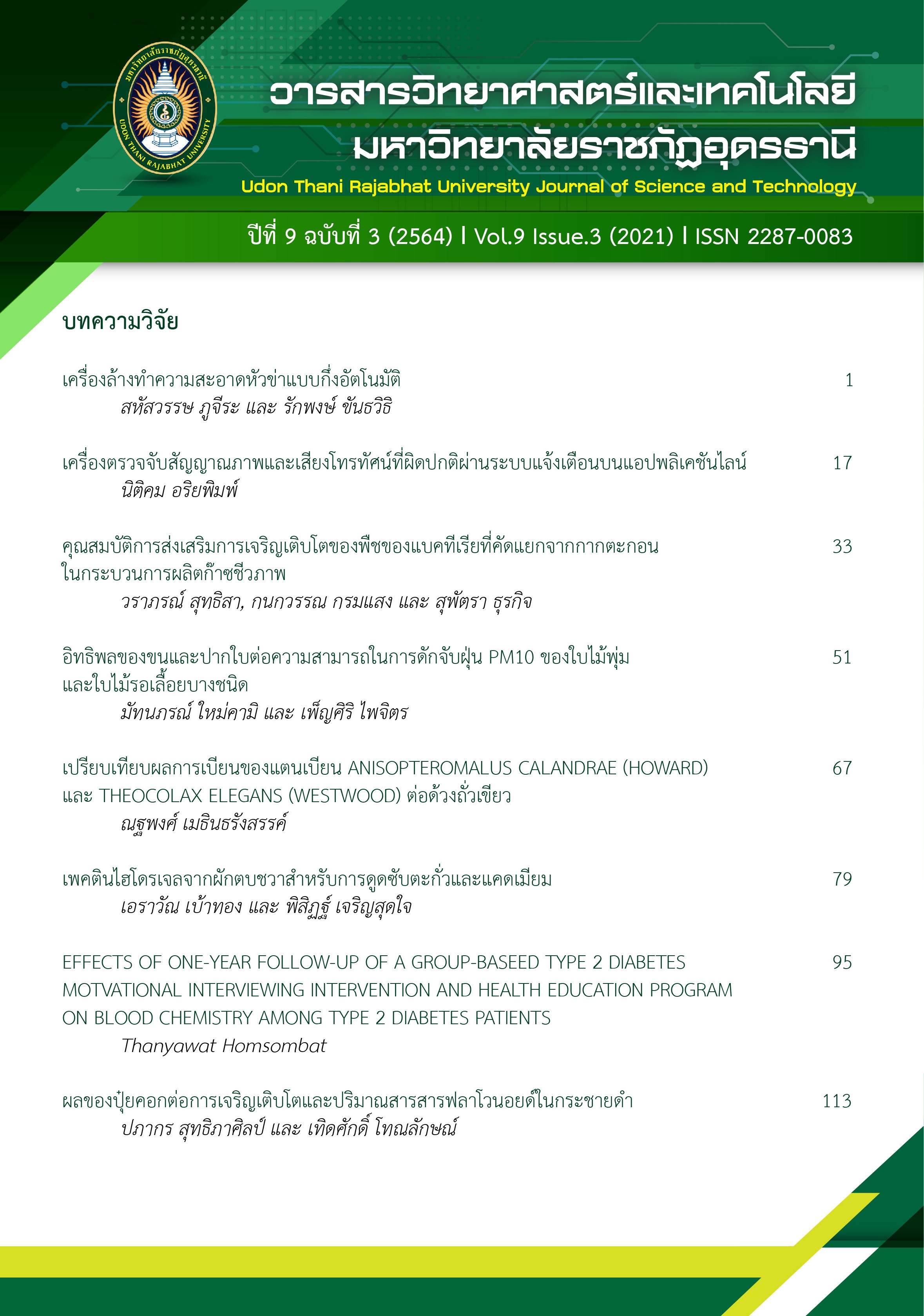ผลของการสร้างแรงจูงใจจากการสัมภาษณ์และโปรแกรมสุขศึกษาในระยะเวลา 1 ปี ที่มีต่อสารเคมีในเลือดของผู้ป่วยเบาหวานชนิดที่ 2
Main Article Content
บทคัดย่อ
การให้โปรแกรมสุขศึกษาและการสัมภาษณ์เพื่อสร้างแรงจูงใจของผู้ป่วยเบาหวานชนิดที่ 2 ต่อระดับสารเคมีในเลือด เป็นการวิจัยกึ่งทดลองระยะเวลา 1 ปี เพื่อติดตามการให้โปรแกรมสุขศึกษาและการสัมภาษณ์เพื่อสร้างแรงจูงใจของผู้ป่วยเบาหวานชนิดที่ 2 ต่อระดับสารเคมีในเลือด กลุ่มตัวอย่างคือผู้ป่วยเบาหวานชนิดที่ 2 จำนวน 70 คน ที่โรงพยาบาลส่งเสริมสุขภาพตำบลหนองนาคำ อำเภอเมือง จังหวัดอุดรธานี ผู้ป่วยมารับยาทุกๆ 2 เดือน พยาบาลจะเจาะเลือดเพื่อตรวจหาค่าสารเคมีในเลือด จากนั้นจะได้รับโปรแกรมการให้สุขศึกษา และการสัมภาษณ์เพื่อสร้างแรงจูงใจ โดยค่าความเที่ยงตรง (Index of item objective congruence: IOC) ของโปรแกรมการให้สุขศึกษาเท่ากับ 0.78 และค่าความเที่ยงตรงของโปรแกรมการให้สุขศึกษาเท่ากับ 0.82 สถิติเชิงพรรณนา คือ ค่าเฉลี่ย ( ) และส่วนเบี่ยงเบนมาตรฐาน (S.D.) และ สถิติเชิงอนุมาน คือ paired t-test เพื่อเปรียบเทียบระดับสารเคมีในเลือดก่อนและหลังการทดลอง ที่ระดับนัยสำคัญทางสถิติ 0.05
ผลการศึกษาพบว่ากลุ่มตัวอย่าง 70 คน เพศหญิง 62 คน (ร้อยละ 88.57) อายุเฉลี่ย 60 ปี (S.D. = 6.70) ดัชนีมวลกายส่วนใหญ่อยู่ในช่วงน้ำหนักเกิน 34 คน (ร้อยละ 48.57, เฉลี่ย = 25.03 (S.D. = 4.10) มีรอบเอวเกินค่ามาตรฐาน 12 คน (ร้อยละ 19.05) มีประวัติเป็นโรคเบาหวานและได้รับยา 1-12 ปี (เฉลี่ย 6.40 ปี) โดยมากที่สุดคือ น้อยกว่า 3 ปี ร้อยละ 40.00 รองลงมาคือ 10-12 ปี ร้อยละ 25.71 จากผลการศึกษาค่าเฉลี่ยของระดับน้ำตาลสะสมในเลือด (HbA1c) ก่อนและหลังการทดลองไม่แตกต่างอย่างมีนัยสำคัญทางสถิติ (p=0.71) เมื่อเปรียบเทียบระดับน้ำตาลในเลือดหลังอดอาหารอย่างน้อย 8 ชั่วโมง (FBS) ระหว่างก่อนการทดลองกับหลังการทดลองครั้งที่ 2 และหลังการทดลองครั้งที่ 5 และระหว่างหลังการทดลองครั้งที่ 2 กับหลังการทดลองครั้งที่ 5 ผลการศึกษาพบว่า แตกต่างกันอย่างมีนัยสำคัญทางสถิติ (F=2.49, p=0.03; F=4.22, p=0.04; F=4.21, p=0.04; F=4.21, p=0.04 ตามลำดับ) ในขณะที่ก่อนการทดลอง ระดับของไขมันในเลือดทุกชนิด พบว่าไม่แตกต่างจากค่าเฉลี่ยของไขมันในเลือดหลังการทดลอง (1 ปี) (p=0.67, p=0.43, p=0.81, p=0.55 ตามลำดับ)
Article Details
เอกสารอ้างอิง
American Association of Clinical Endocrinologists and American College of Endocrinology. (2015). Clinical practice guidelines for developing a diabetes mellitus
Bantle, J. P. Wylie-Rosett, J., Albright, A. L., Apovian, C. M., Clark, N. G., Franz, M. J., Hoogwerf, B. J., Lichtenstein, A. H., Mayer-Davis, E., Mooradian, A. D., & Wheeler M. L. (2008). Nutrition recommendations and interventions for diabetes: a position statement of the American Diabetes Association. Diabetes Care, 31(1), S61–S78.
Boren, S. A., Fitzner, K. A. Panhalkar, P. S., & Specker, J. E. (2009). Costs and benefits associated with diabetes education: a review of the literature. The Diabete Educator, 35(1), 72–96.
Dungan, K. M. (2008). 1, 5-anhydroglucitol (GlycoMark) as a marker of short-term glycemic control and glycemic excursions. Expert Rev. Mol. Diagn, 8(9), 9–19.
Grundy, S. M., Stone, N. J., Bailey, A. L., Beam, C., Birtcher, K. K., Blumenthal, R. S., Braun, L. T., de Ferranti, S., Faiella-Tommasino, J., Forman, D. E., Goldberg, R., Heidenreich, P. A., Hlatky, M. A., Jones, D. W., Lloyd-Jones, D., Lopez-Pajares, N., Ndumele, C. E., Orringer, C. E., Peralta, C. A., Saseen, J. J., Smith Jr, S. C., Sperling, L., Virani, S. S., & Yeboah, J. (2018). Guideline on the Management of Blood Cholesterol: A Report of the American College of Cardiology/American Heart Association Task Force on Clinical Practice Guidelines. Circulation, 139(25), 1-11.
Hemmati, M. M., Razmara, S., & Niazkhani, Z. (2017). Effects of Face-to-Face and Telephone-Based Family-Oriented Education on Self-Care Behavior and Patient Outcomes in Type 2 Diabetes: A Randomized Controlled Trial. Journal of Diabetes Research, 11, 1-10.
Koro, C. E., Bowlin, S. J., Bourgeois, N., & Fedder. D. O. (2004). Glycemic Control From 1988 to 2000 Among U.S. Adults Diagnosed With Type 2 Diabetes A preliminary report. Diabetes Care 27(1): 17-20.
Lane, C., Huws-Thomas, M., Hood, K., Rollnick, S., Edwards, K., & Robling, M. (2005). Measuring adaptations of motivational interviewing: The development and validation of the behavior change counseling index (BECCI). Patient Educ. Couns, 56(3), 166-173.
Lindsey, C. C., Carter, A. W., Mangum, S., Dorothy Greene, D., Richardson, A., Brown, S. J., Essary, J. L., & McCandless, B. (2004). A prospective, randomized, multicentered controlled trial to compare the annual glycemic and quality outcomes of patients with diabetes mellitus monitored with weekly fructosamine testing versus usual care. Diabetes Technol Ther, 6(7), 370–7.
Miller, W. R., & Rollnick, S. (2002). Motivational interviewing: Preparing people for change. New York: Guilford Press. p. 271.
Miller, S. T. (2011). Diabetes and psychological profile of younger rural African American women with type 2 diabetes. J. Health Care Poor Underserved, 22(4), 1239-1252.
Miller S. T. & Akohoue S. A. (2017). Two-year follow-up study of a group-based diabetes medical nutrition therapy and motivational interviewing intervention among African American women. Patient Relat Outcome Meas. 15(8): 57-61.
Ministry of Public Health. (2018). Thailand Noncommunicable Disease and Injury Behavior Risk Surveillance Survey. Retrieved September 23, 2018, from http://ghdx.healthdata.org/record/thailand-noncommunicable -disease-and-injury-behavior-risk-surveillance-survey-2018
Munro, B. H. (2005). Statistical methods for health care research (5th ed.). Philadelphia: Lippincott Williams & Wilkins.
Nongnakham primary care unit. Statistics of patients. (2018). Nongnakham primary care unit, Muang district, Udon Thani province. Department of control disease, Ministry of public health. Retrieved September 23, 2018, from http://www.thaincd.com/2016/mission/documents.php?tid= 32&gid=1020&searchText=& pn= 2.
Noble, J. A. (2015). Immunogenetics of type 1 diabetes: A comprehensive review J. Autoimmun, 64(7), 101-12.
Padilla, J., Olver, T. D., Thyfault, J. P., & Fadel, P. J. (2015). Role of habitual physi cal activity in modulating vascular actions of insulin. Exp. Physiol, 100(12), 759-771.
Kenneth Resnicow, K., McMaster, F., Bocian, A., Harris, D., Zhou, Y., Snetselaar, L., Schwartz, R., Myers, E., Gotlieb, J., Foster, J., Hollinger, D., Smith, K., Woolford, S., Mueller, D., &d Wasserman, R. C. (2015). Motivational interviewing and dietary counseling for obesity in primary care: An RCT. Pediatrics, 135(4), 649-657.
Roberto, S., & Crisafulli, A. (2017). Consequences of Type 1 and 2 Diabetes Mellitus on the Cardiovascular Regulation During Exercise: A Brief Review. Current Diabetes Reviews, 13(6), 560-565.
Stratton. I. M., AAdler, A. I., Neil, H. A., Matthews, D. R., Manley, S. E., Cull, C. A., Hadden, D., Turner, R. C. and Holman R. (2017). Association of glycaemia with macrovascular and microvascular complications of type 2 diabetes (UKPDS 35): prospective observational study. BMJ. 12(321): 405-12.
Toobertm, D. J., Hampson, S. E., & Glasgow, R. E. (2000). The summary of diabetes self-care activities measure: results from 7 studies and a revised scale. Diabetes Care, 23(7), 943–950.
Whittemore, R., Melkus, G. D., Sullivan, A., & Grey, M. (2004). A nurse-coaching intervention for women with type 2 diabetes. Diabetes Educ, 30(3), 795-804.


